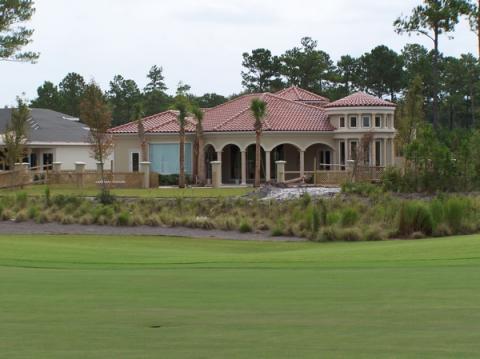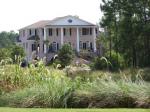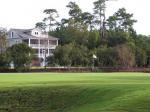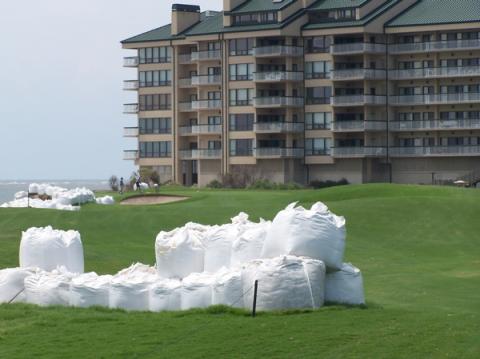
Tuscan-style homes at Grande Dunes are set well back from the Members Club and about a mile from the ocean.
A few days ago, I posted the highest and lowest current prices for homes in a few communities I have visited. Here are a few more.
Wild Dunes, Isle of Palms, SC
High: $2.9 million, 2,800 sq. ft, 4 BR, 4 BA, penthouse corner unit overlooking ocean, 18th Green (see note below).
Low: $320,000, 1,800 sq. ft., 3 BR, 3 BA, ocean view, 1/5th share
Mother Nature isn't a big fan of Wild Dunes. The beach resort just north of Charleston took a nasty hit from Hurricane Hugo in the late 1980s, slicing off the last couple of ocean holes on the excellent Tom Fazio course (the second 18 at Wild Dunes threads its way among older homes and does not have the panache of the ocean links). After reconstruction and a decade of relative peace, the ocean began to eat away at the 18th fairway and green. Last August, the green lost and fell onto the beach. When we played the course just a few weeks earlier, waves were lapping at the base of the seven-story condo behind the green; it was hard to imagine how the greenside condos would survive the encroaching seas. Anyone interested in oceanfront property at Wild Dunes should proceed with caution.
River Towne Country Club, Mt. Pleasant, SC
High: $1.5 million, ½ acre, 3,650 sq. ft., 4 BR, 3 ½ BA, dock on a deep tidal creek leading to Wando River.
Low: $400,000, NA, 3,000 sq. ft., 4 BR, 2 ½ BA, pond view.
River Towne is one of the Ginn properties, perhaps not as posh as developer Bobby Ginn's renowned Florida properties but at the highest end in Mt. Pleasant, a thriving and growing town nestled between Charleston and Isle of Palms (see above). The course, designed by Arnold Palmer, includes 13 holes along the Wando River and Horlbeck Creek and hosts an LPGA event each spring. Ginn, ever the aggressive marketer, engaged Annika Sorenstam to be the host of the tournament. Although I don't know what it looks like on the inside, the price tag of $400,000 for the single-family home listed above does seem like a bargain for this community, which is close to shopping, the beach and a great American city.
Isle of Palms (see above). The course, designed by Arnold Palmer, includes 13 holes along the Wando River and Horlbeck Creek and hosts an LPGA event each spring. Ginn, ever the aggressive marketer, engaged Annika Sorenstam to be the host of the tournament. Although I don't know what it looks like on the inside, the price tag of $400,000 for the single-family home listed above does seem like a bargain for this community, which is close to shopping, the beach and a great American city.
Grande Dunes, Myrtle Beach, SC
High: $3.75 million, 11,100 sq. ft., 4 BR, 4 BA
Low: $449,000, 1,400 sq. ft., 2 BR, 2 BA
Grande Dunes covers a wide swath of area in the heart of the Grand Strand, with properties on the ocean and the Intracoastal Waterway a couple of miles inland (prices above are for the properties near the river). With a well-regarded resort course and a newer Members Club, also available to guests staying at Grande Dunes hotel, the community offers its residents upscale golf to go with the upscale prices on the homes. I thought the Members Club layout, by Nick Price and local boy Craig Schreiner, was a bit wimpy, with wide fairways and, for the most part, easily accessible greens. I prefer the daily fee course by Roger Rulewich. In any event, homes inside the gates are beautiful, and land is still available for those who want their Tuscan style homes built to their own specs.
Debordieu Colony, Georgetown, SC
High: $5.2 million, 8,225 sq. ft, 6 BR, 5 BA, ocean frontage, wine cellar, media room, elevator.
Low: $725,000, 3,000 sq. ft., 3 BR, 3 BA, villa, private pool, short cut to beach.
An independent study last year determined that Pete Dye-designed golf courses have the most positive affect on house values in a community, more so than Nicklaus, Fazio and R. T. Jones courses. Dye's Debordieu course lacks some of the drama of his other more celebrated layouts, but his restraint lets the low country terrain do the talking. Unfortunately, he was called in well after all the good beachfront property was sold so you won't see the ocean from anywhere on the course (although you can hear it and smell the salt air). Everyone in the community is, at most, a short, inside-the-gates bike ride from the beach, the only golf community on the south end of the Grand Strand that can boast that.
course lacks some of the drama of his other more celebrated layouts, but his restraint lets the low country terrain do the talking. Unfortunately, he was called in well after all the good beachfront property was sold so you won't see the ocean from anywhere on the course (although you can hear it and smell the salt air). Everyone in the community is, at most, a short, inside-the-gates bike ride from the beach, the only golf community on the south end of the Grand Strand that can boast that.
Ford Plantation, Richmond Hill, GA
High: $4 million, 3 acres, 8,000 sq. ft., 4 BR, 4 ½ BA, lake view.
Low: $900,000, 2.4 acres, 3,000 sq. ft., 3 BR, 3 BA, equestrian oriented, paddock views.
Dye again, and also somewhat restrained for him, but the magnificent piece of land along the Ogeechee River was all he needed. Ford Plantation was Henry Ford's southern home (one of them), and the main house has preserved his and wife Clara's bedrooms. Those looking at property at Ford can stay in the main house and take breakfast in the dining room where the Fords did. The plantation is loaded with history - Sherman spared most of it during his savaging of Savannah - and live oaks, and my experience was that developer and golf course staff are down to earth, even if prices are not. If you can afford it, there are few better places.

Last August, sand bags were all that was holding up the 18th fairway and green. By September, the sand bags had lost, and water was already lapping at the base of the condos behind the green.
























